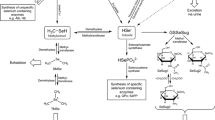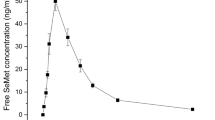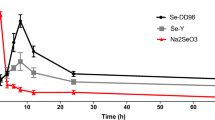Abstract
There is no data or literature on the effects of supplementing infants with yeast selenium, although its intestinal absorption and bioavailability are higher in adults compared with other selenium compounds.
The aim of the present investigation was to study the impact of selenium enriched yeast on the serum selenium concentration of preterm infants living in a low selenium area (Hungary).
Twenty-eight preterm infants with mean ± SD birth weight of 962 ± 129 g and gestational age 27 ± 1 wk were randomized into two groups at birth with respect to selenium supplementation. In the supplemented group (n = 14) infants received 4.8 mg yeast selenium containing 5 μg selenium daily via nasogastric drip during the first 14 postnatal days. The nonsupplemented infants were used as a reference group.
In the supplemented group, the serum selenium concentration increased from 32.1 ± 8.5 μg/L to 41.5 ± 6.5 μg/L and in the nonsupplemented group it decreased from 25.9 ± 6.8 μg/L to 18.2 ± 6.4 μg/L from birth in two weeks time. Compared with previous studies, our results suggest that the bioavailability of selenium in the form of yeast selenium is higher than that of other selenium compounds used for preterm infants. We did not observe any complications or side-effects owing to enterai yeast selenium supplementation.
We conclude that selenium enriched yeast is a safe and an effective form of short-term enterai selenium supplementation for infants.
Similar content being viewed by others
References
J. K. Friel, W. L. Andrews, D. R. Long, and M. R. L’Abb, Selenium status of very low birth weight infants,Pediatr. Res. 34, 293–296 (1993).
I. Lombeck, K. Kasparek, H. D. Harbisch, et al., The selenium state of healthy children, I: serum selenium concentration at different ages; activity of glutathione peroxidase of erythrocytes at different ages; selenium content of food of infants,Eur. J. Pediatr. 125, 81–88 (1977).
M. van Caillie-Bertrand, H. J. Degenhart, and J. Fernandes, Influence of age on the selenium status in Belgium and the Netherlands,Pediatr. Res. 20, 574–576 (1986).
K. B. Sluis, B. A. Darlow, P. M. George, N. Mogridge, B. A. Dolamore, and C. C. Winterbourn, Selenium and glutathione peroxidase levels in premature infants in a low selenium community (Christchurch, New Zealand),Pediatr. Res. 32, 189–194 (1992).
G. Alfthan, G. Bogye, A. Aro, and J. Feher, The human selenium status in Hungary,J. Trace Elem. Electrolytes Health. Dis. 6, 233–238 (1992).
National Research Council, Recommended dietary allowances, 10th ed., Washington, DC: National Academy Press, pp. 217–224 (1989).
P. Anttila, S. Salmela, J. Lehto, and O. Simell, Serum zinc, copper and selenium concentration in healthy mothers during pregnancy, puerperium, and lactation: a longitudinal study, in:Vitamins and minerals in pregnancy and lactation, E. F. L. Berger, Raven Press, 265–272 (1988).
M. K. McGuire, S. Burgert, J. A. Milner, et al., Selenium status of lactating women is affected by the form of selenium consumed,Am. J. Clin. Nutr. 58, 649–652 (1993).
H. Robberecht, E. Roekens, M. van Caillie-Bertrand, H. Deelstra, and R. Clara, Longitudinal study of the selenium content in human breast milk in Belgium,Acta Pediatr. Scand. 74, 254–258 (1985).
J. Kumpulainen, L. Salmenperä, M. A. Siimes, P. Koivistoinen, J. Lehto, and J. Perheentupa, Formula feeding results in lower selenium status than breast-feeding or selenium supplemented formula feeding: a longitudinal study,Am. J. Clin. Nutr. 45, 49–53 (1987).
M. K. McGuire, S. Burgert, J. A. Milner, et al., Selenium status of infants is influenced by supplementation of formula or maternal diets,Am. J. Clin. Nutr. 58, 643–648 (1993).
A. M. Smith, G. M. Chan, L. J. Moyer-Mileur, C. E. Johnson, and B. R. Gardner, Selenium status of preterm infants fed human milk, preterm formula, or seleniumsupplemented preterm formula,J. Pediatr. 119, 429–433 (1991).
A. M. Smith, M. F. Picciano, J. A. Milner, and T. F. Hatch, Influence of feeding regimens on selenium concentrations and glutathione peroxidase activities in plasma and erythrocytes of infants,J. Trace Elem. Exp. Med. 1, 209–216 (1988).
N. W. Solomon, B. Torun, M. Janghorbani, M. J. Christensen, V. R. Young, and F. H. Steinke, Absorption of selenium from milk protein and isolated soy protein formulas in preschool children: studies using stable isotope tracer 74Se,J. Pediatr. Gastroenterol. Nutr. 5, 122–126 (1986).
G. Alfthan, A. Aro, H. Arvilommi, and J. K. Huttunen, Selenium metabolism and platelet glutathione peroxidase activity in healthy Finnish men: The effect of selenium yeast, selenite and selenate supplementation,Am. J. Clin. Nutr. 53, 120–125 (1991).
O. A. Levander, G. Alfthan, H. Arvilommi, C. G. Gref, J. K. Huttunen, M. Kataja, P. Koivistoinen, and J. Pikkarainen, Bioavailability of selenium to Finnish men as assessed by platelet glutathione peroxidase activity and other blood parameters,Am. J. Clin. Nutr. 37, 887–897 (1983).
G. N. Schrauzer and D. A. White, Selenium in human nutrition: dietary intakes and effects of supplementation,Bioinorg. Chem. 8, 303–318 (1978).
G. Alfthan and J. Kumpulainen, Determination of selenium in small volumes of blood plasma and serum by electrothermal atomic absorption spectrometry,Anal. Chim. Acta 140, 221–227 (1982).
O. A. Levander, Considerations on the assessment of selenium status,Fed. Proc. 44, 2579–2583 (1985).
Y. Xia, K. E. Hill, and R. F. Burk, Biochemical studies of a selenium-deficient population in China: measurement of selenium, glutathione peroxidase and other oxidant defense indices in blood,J. Nutr. 19, 1318–1326 (1989).
G. Lockitch, B. Jacobson, G. Quigley, P. Dison, and M. Pendray, Selenium deficiency in low birth weight neonates: an unrecognized problem,J. Pediatr. 114, 865–870 (1989).
R. E. Litov and G. F. Combs, Selenium in pediatric nutrition,Pediatrics 87, 339–351 (1991).
N. Rudolph, O. Preis, E. I. Bitzos, et al., Hematologic and selenium status of low birth-weight infants fed formulas with and without iron,J. Pediatr. 99, 57–62 (1981).
O. A. Levander, Upper limit of selenium in infant formulas,J. Nutr. 119, 1869–1873 (1989).
L. Daniels, R. Gibson, and K. Simmer, Randomized clinical trial of parenteral selenium supplementation in preterm infants,Arch. Dis. Child. 74, F158-F164 (1996).
N. M. Griffiths, R. G. H. Stewart, and M. F. Robinson, The metabolism of (75Se) selenomethionine in four women,Br. J. Nutr. 35, 373–382 (1976).
M. Robinson, The New Zealand selenium experience,Am. J. Clin. Nutr. 48, 521–534 (1988).
C. D. Thomson and M. F. Robinson, Urinary and fecal excretions and absorption of a large supplement of selenium: superiority of selenate over selenite,Am. J. Clin. Nutr. 44, 659–663 (1986).
G. Q. Yang, Keshan disease: an endemic selenium-related deficiency disease, in:Trace elements in nutrition of children, R. K. Chandra, ed., Raven Press, 273–290 (1985).
N. E. Vinton, K. A. Dahlstrom, C. T. Stroebel, and M. E. Ament, Macrocytosis and pseudoalbinism, manifestations of selenium deficiency,J. Pediatr. 111, 711–717 (1987).
S. Yannicelli, K. M. Hambidge, and M. F. Picciano, Decreased selenium intake and low plasma selenium concentrations leading to clinical symptoms in a child with propionic acidaemia,J. Inherit. Metab. Dis. 15, 261–268 (1992).
P. Varo, G. Alfthan, J. K. Huttunen, and A. Aro, Nationwide selenium supplementation in Finland — effects on diet, blood and tissue levels, and health, in:Selenium in biology and human health, R. F. Burk, ed., Berlin: Springer-Verlag, 198–208 (1994).
J. Kumpulainen, E. Vuori, P. Kuitunen, S. Makinen, and R. Kara, Longitudinal study on the dietary selenium intake of exclusively breast-fed infants and their mothers in Finland,Int. J. Vitam. Nutr. Res. 53, 420–426 (1983).
A. M. Smith, L. V. Chen, and M. R. Thomas, Selenate fortification improves selenium status of term infants fed soy formula,Am. J. Clin. Nutr. 61, 44–47 (1995).
P. Hågå and G. Lunde, Selenium and vitamin E in cord blood from preterm and full term infants,Acta Paediatr. Scand. 67, 735–739 (1978).
N. Rudolph, M. S. Schiller, and S. L. Wong, Vitamin E and selenium in preterm infants: lack of effect on clinical patency of ductus arteriosus,Intern. J. Vit. Nutr. Res. 59, 140–146 (1989).
S. Amin, S. Y. Chen, P. J. Collipp, M. Castro-Magano, V. T. Maddaiah, and S. W. Klein, Selenium in premature infants,Nutr. Metab. 24, 331–340 (1980).
J. K. Friel, R. S. Gibson, A. Peliowski, and J. Watts, Serum zinc, copper and selenium concentrations in preterm infants receiving enterai nutrition or parenteral nutrition supplemented with zinc and copper,J. Pediatr. 104, 763–768 (1984).
B. A. Darlow, T. E. Inder, P. J. Graham, K. B. Sluis, T. J. Malpas, and B. J. Taylor, et al., The relationship of selenium status to respiratory outcome in the very low birth weight infant,Pediatrics 96, 314–319 (1995).
Author information
Authors and Affiliations
Rights and permissions
About this article
Cite this article
Bogye, G., Alftham, G. & Machay, T. Bioavailability of enterai yeast—selenium in preterm infants. Biol Trace Elem Res 65, 143–151 (1998). https://doi.org/10.1007/BF02784266
Received:
Revised:
Accepted:
Issue Date:
DOI: https://doi.org/10.1007/BF02784266




